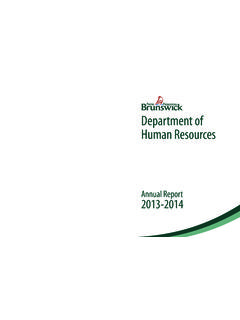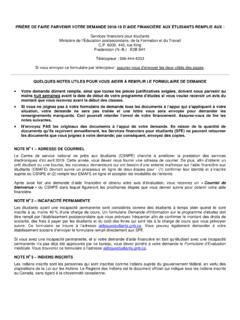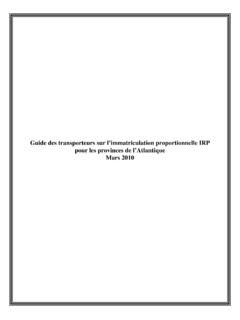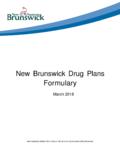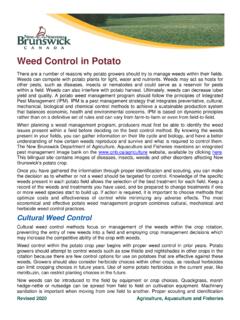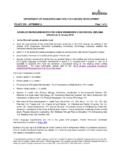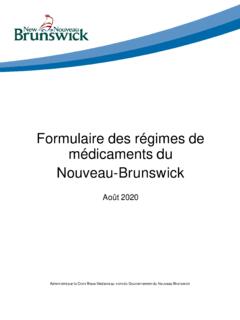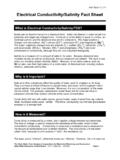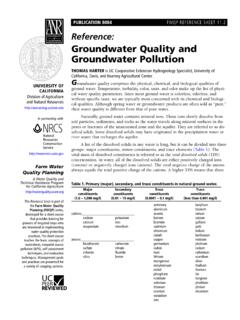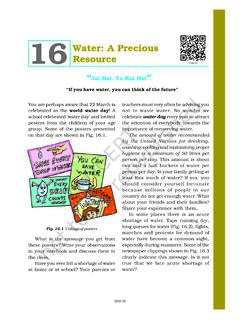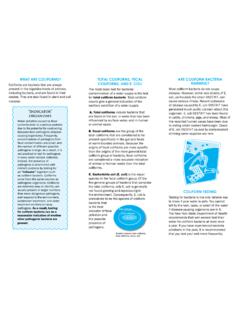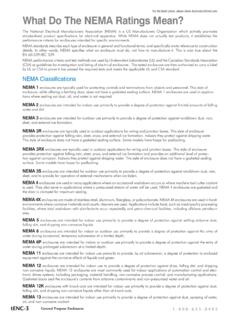Transcription of FACTS ON DRINKING WATER Coliform Bacteria – Total ...
1 FACTS ON DRINKING WATER Coliform Bacteria Total Coliforms & Total coli forms are a group of Bacteria commonly found in the environment, for example in soil or vegetation, as well as the intestines of mammals, including humans. Total Coliform Bacteria are not likely to cause illness, but their presence indicates that your WATER supply may be vulnerable to contamination by more harmful microorganisms. Escherichia coli ( ) is the only member of the Total coli form group of Bacteria that is found only in the intestines of mammals, including humans. The presence of in WATER indicates recent fecal contamination and may indicate the possible presence of disease-causing pathogens, such as Bacteria , viruses, and parasites.
2 Although most strains of Bacteria are harmless, cer tain strains, such as 0157:H7, may cause illness. Sources Total coli forms and are used as indicators to measure the degree of pollution and sanitary quality of well WATER , because testing for all known pathogens is a complicated and expensive process. The main source of pathogens in DRINKING WATER is through recent contamination from human or animal waste, from Improperly treated septic and sewage discharges Leaching of animal manure Stormwater runoff Domestic animals or wildlife During and after precipitation, Bacteria and other harmful microorganisms from any of these sources may be washed into rivers, lakes, or groundwater.
3 Poor well construction or poor maintenance can increase the risk of groundwater contamination. Health Risks In WATER , coli form Bacteria have no taste, smell, or colour. They can only be detected through a laboratory test. The Canadian DRINKING WATER Quality Guideline for Total coliforms is none detec table per 100 mL. The Canadian DRINKING WATER Quality Guideline for Escherichia coli ( ) is none detectable per 100 mL. Maximum Acceptable Concentration for DRINKING WATER = none detectable per 100 mL This means that in order to conform to the guideline: For every 100 mL of DRINKING WATER tested, no Total coliforms or should be detected.
4 When DRINKING WATER is tested for Total coli forms and and the WATER is safe to drink, the results may be presented in a variety of formats: Absent 0 colony forming units per 100 millilitres (0 CFU/100 mL) Less than 1 colony forming unit per 100 millilitres (< 1 CFU/100mL) Non-detect (ND) 0 most probable number per 100 millilitres (MPN/100 mL) only when a Bacteria count is requested in DRINKING WATER indicates the WATER has been contaminated with fecal material that may contain disease- causing microorganisms, such as certain Bacteria , viruses, or parasites. The health effects of exposure to disease-causing Bacteria , viruses, and parasites in DRINKING WATER area varied.
5 The most common symptoms of waterborne illness include nausea, vomiting, and diarrhea. Infants, the elderly, and those with compromised immune systems may suffer more severe effects. In ex tr eme cases some pathogens may infect the lungs, skin, eyes, nervous system, kidneys, or liv er and the effects may be more severe, chronic, or ev en fatal. You should not assume that your WATER is safe to drink just because it has not made you sick in the past. If Bacteria are pr esent in your WATER , there is a risk that it could make you ill. Testing Regularly test your well WATER for a standard suite of bacterial and chemical parameters, including Total coliforms and E.
6 Coli. Use an SCC or CALA accredited WATER testing laboratory. Find a list of ac credited laboratories at or Samples must be kept cool and be delivered to the lab within 24 hours of sampling. For more information on WATER testing services at Provincial Analytical Services Laboratory, please see Department of Envir onment s WATER testing services at The cost can vary depending on the lab and the number of parameters being tested. Test Results If your test results found Bacteria to be present, your WATER is not safe to drink. Retest your WATER to confirm the ori ginal results. Boil your WATER while you are waiting for your test results, or use another source for DRINKING , preparing infant formulas, pr eparing jui ces and ice cubes, washing fruits and vegetables, cooking, and brushing your teeth.
7 To destroy pathogens, bring WATER to a rolling boil for one minute. You do not usually need to boil WATER for other household purposes. Those who can avoid swallowing the WATER may shower, bathe, and wash using the well WATER . Toddlers and infants should be sponge bathed. Dishes and laundry may be washed in well WATER either by hand or machine. If is present in the WATER , it means there has been recent fecal contamination and other pathogens may be present. Investigate the source of the Bacteria and take correc tive measures. If is absent, but only Total coli forms are present, it could mean one of three things: A layer of Bacteria may have developed within your well or plumbing system.
8 This layer of Bacteria is called a biofilm. Surface WATER may be getting into your well. This increases the risk of animal waste contaminating your WATER sooner or later. Your well WATER may come from an aquifer that contains Bacteria . This can happen when groundwater comes from a shallow source. Boiling WATER To kill microorganisms, you must keep WATER at a rolling boil for at least one minute. WATER can be boiled either in a pot or kettle on a stove, in a microwave oven, or in an electric kettle without an automatic shut-off. Solutions If is confirmed to be pr esent in the well WATER : Inspect the well construction and repair or rehabilitate the existing well.
9 Check separation distances between wells and sources of contamination. Determine if there is a source of near your well, such as a malfunctioning septic system. Table 1 shows the minimum distances that must be maintained according to the NB WATER Well Regulation 90-79 under the Clean WATER Act and the NB On-site Sewage Disposal System Regulation 09-137 under the Public Health Act. Reconstruct the existing well, if necessary. In some cases it may be necessary to pr operly decommission the existing well and construct a new well. Contact New Brunswick Department of Environment for more information on well decommissioning or setbacks under the Clean WATER Act.
10 In the interim, use WATER that has been properly boiled, bottled WATER , or another source of WATER that has been tested and found to be safe for - DRINKING - Preparing infant formula - Preparing jui ces or ice cubes - Washing fruits and vegetables - Cooking - Brushing your teeth Install a treatment system to treat your current source of WATER if there is no other source of WATER available and correc tion of the problem is not possible. If is absent, but only Total coli forms are pr esent, solutions depend on why Total coli forms are present: If a biofilm has developed within your well or plumbing system, you can disinfect your well and plumbing sy st em.

